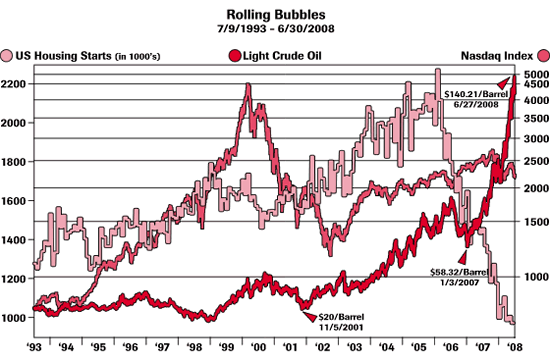2008 Q2 | The Schopf Stop
 First, it was the technology bubble of the late 1990’s. Shortly thereafter, we experienced the real estate bubble. Now, we may be witnessing the third bubble—commodities, specifically energy.
First, it was the technology bubble of the late 1990’s. Shortly thereafter, we experienced the real estate bubble. Now, we may be witnessing the third bubble—commodities, specifically energy.
The chart below shows us how painful the unwinding of a speculative bubble can be. The Nasdaq index exceeded 5,000 eight years ago but still remains more than 50% below the peak level. Housing is a similar story as the seasonably adjusted number of new homes starts has declined by 50% from 2004 and 2005 levels. Oil is showing signs of similar speculation as massive amounts of money are flooding into the sector. The price of oil is up 40% just this quarter.
As Jim notes in his quarterly commentary, breaking the price of oil is critical to the recovery of the markets. High energy prices are the equivalent of an added tax, which weakens the economy while creating disruptive inflationary pressure. The Fed is stuck between the proverbial rock and hard place as they try to decide whether to stimulate growth or fight inflation. For now, the Fed has exercised an accommodative monetary policy in an effort to aid the financial industry and the housing market. The ramifications have been a weak U.S. dollar and exploding energy prices. The speculative fervor surrounding energy will subside as the financial crisis fades and the Fed shifts its attention to inflation.
Bubbles are particularly frustrating as they drain money from other asset classes and skew investment performance. As with all bubbles, however, it is difficult to predict their duration. Although the energy bubble may not burst in spectacular fashion due to fundamental supply and demand imbalances created over the years, a material drop in energy prices will have a positive impact on the markets.

—Eric Schopf



